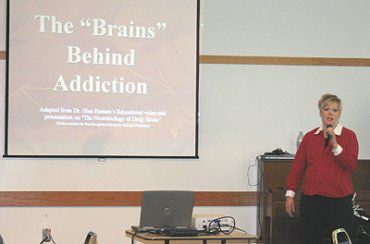Each social service agency in Emery County was invited to a luncheon and seminar called Interagency Celebrate Recovery. It was held at the Museum of the San Rafael on Sept. 25 and was geared to teach all social service employees more about what can be done to help the residents of this area.
Jennifer Thomas, a licensed clinical social worker with Four Corners Behavioral Health opened the meeting by welcoming all the agencies and their representatives. “We get many calls from every agency asking questions about how to deal with their clients with addictions,” she said. “Since this is National Recovery Month, we decided to talk about co-occuring disorders. Addictions in some form hits every family at one time or another. Co-occurring disorders are those which affect people in more than one way,” said Thomas.
Common co-occurring disorders are: depression; bipolar disorder; attention disorders; anxiety disorders; and personality disorders. Someone with one of these disorders may turn to alcohol or drugs to treat the disorder. “It has been discussed which comes first, the mental illness or the addiction,” stated Thomas. “Research has found that the mental illness usually presents first.”
When a person with a mental disorder begins to feel out of control, many times they will turn to substances to self medicate. “It is critical to recognize and treat the mental disorder before the person turns to drugs and other substance and becomes addicted,” Thomas added.
Thomas said that in recent times, co-occurring disorders are becoming more prevalent. Many people with depression and substance abuse issues do not get the treatment they need. Even after diagnosis, many people will not believe the diagnosis.
Self defeating behaviors, such as hair pulling, cutting, starvation, etc., are those behaviors that one does to sabotage themselves. Along with these behaviors, a person might display thinking errors. Thinking errors are those things such as excuse making, blaming someone else, justifying, victim playing and anger. These personality disorders are an enduring pattern of the experiences and cultures the person came from.
“What do we do?” asked Thomas. “We must set limits for our clients. We must also be very honest with them. Do not personalize their attacks and have appropriate relationships with them. We must avoid transference of their problems into our own lives. Another effective tool is role playing.”
Thomas explained that Four Corners Behavioral Health has something that will work for just about anyone. There are many financial helps available for those who are in need of treatment. They also provide parenting classes and classes for children and teens who may be having some difficulties. “We have a wellness program for those without insurance,” said Thomas.
Melissa Huntington of Four Corners presented a power point concerning the neurobiology of addictions. This explained the chemicals and their reactions on and in the brain. “Why are addicts so difficult to treat?” Huntington asked. “It is due to several factors. There is the stigma of treatment and the genetics behind the addiction. People have biological, psychological and social contributors to addictions.
“Another reason is the funding. Many people do not have the resources to pay for addiction treatment. We have many options available and will work to find solutions to those problems. There is the length of treatment also. Many people stop treatment too soon. Successful treatment takes at least a year.
“Finally, the complexity of the brain plays a big role in the difficulty of treating addicts. Children with untreated attention deficit hyperactivity disorder are many more times more likely to become addicted to a substance,” said Huntington. Prevention is the key to stopping many people from becoming addicts.
Drug abuse creates an imbalance in the neurotransmitters in the brain. Drugs produce a flood of dopamine in the system and this drains the naturally occurring dopamine from the system. In turn, this action damages the normal functioning of the neuropathways of the brain. The brain’s reward and cognitive systems are then compromised and damage is done to the region of the brain that controls decision making and judgment. This increases a persons vulnerability to become addicted to not only one substance, but any other substance also.
Part 1: A look at substance abuse, awareness, treatment and recovery in Emery County

"Melissa Huntington talks about the effects of addiction on the brain."
